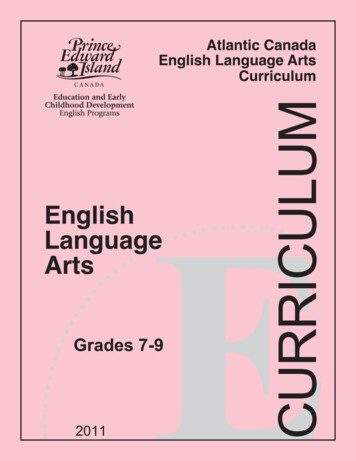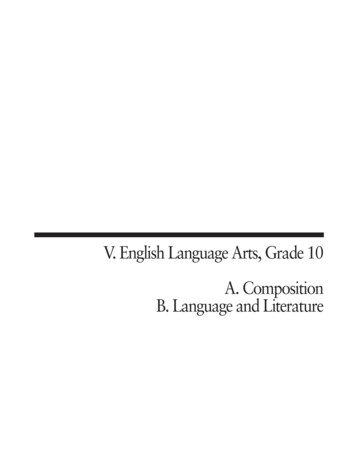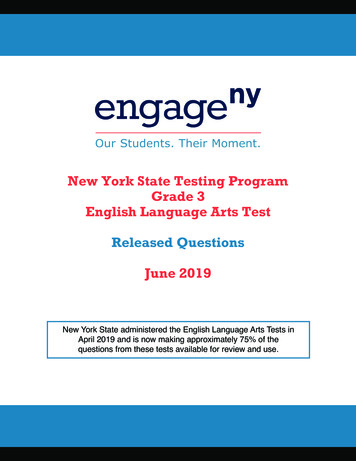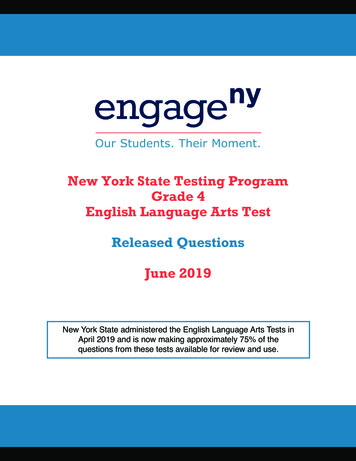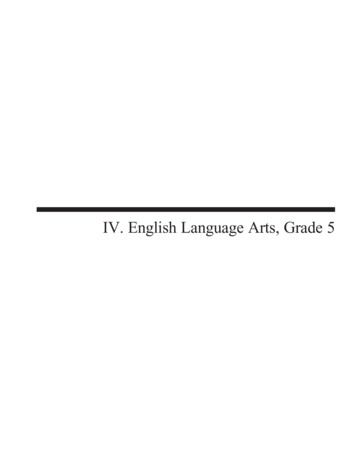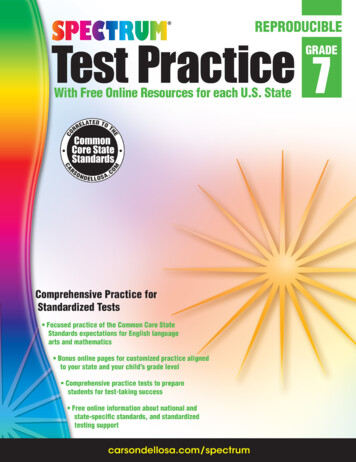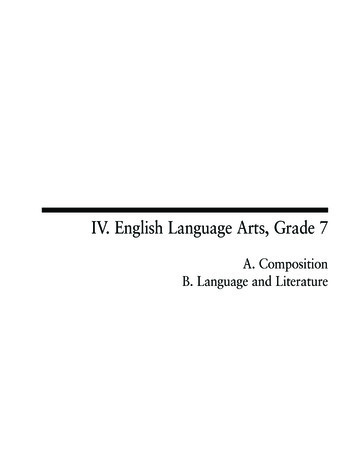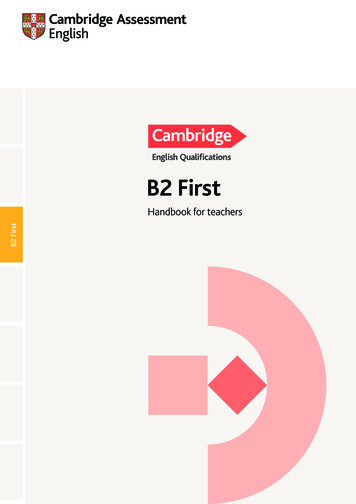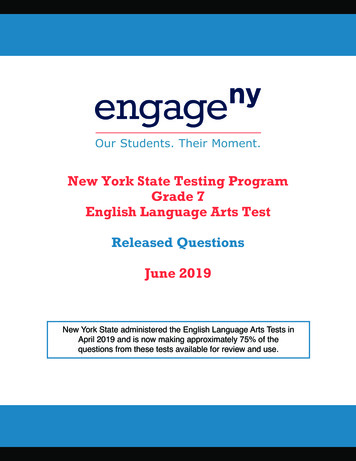
Transcription
New York State Testing ProgramGrade 7English Language Arts TestReleased QuestionsJune 2019New York State administered the English Language Arts Tests inApril 2019 and is now making approximately 75% of thequestions from these tests available for review and use.
THE STATE EDUCATION DEPARTMENT / THE UNIVERSITY OF THE STATE OF NEW YORK / ALBANY, NY 12234New York State Testing ProgramGrades 3–8 English Language ArtsReleased Questions from 2019 ExamsBackgroundIn 2013, New York State began administering tests designed to assess student performance in accordancewith the instructional shifts and rigor demanded by the new New York State P-12 Learning Standards inEnglish Language Arts (ELA). To help in this transition to new assessments, the New York State EducationDepartment (SED) has been releasing an increasing number of test questions from the tests that wereadministered to students across the State in the spring. This year, SED is again releasing large portions ofthe 2019 NYS Grades 3–8 English Language Arts and Mathematics test materials for review, discussion, anduse.For 2019, included in these released materials are at least 75 percent of the test questions that appearedon the 2019 tests (including all constructed-response questions) that counted toward students’ scores.Additionally, SED is providing information about the released passages; the associated text complexity foreach passage; and a map that details what learning standards each released question measures and thecorrect response to each question. These released materials will help students, families, educators, and thepublic better understand the tests and the New York State Education Department’s expectations forstudents.Understanding ELA QuestionsMultiple-Choice QuestionsMultiple-choice questions are designed to assess the New York State P-12 Learning Standards in EnglishLanguage Arts. These questions ask students to analyze different aspects of a given text, including centralidea, style elements, character and plot development, and vocabulary. Almost all questions, includingvocabulary questions, will be answered correctly only if the student comprehends and makes use of thewhole passage.For multiple-choice questions, students select the correct response from four answer choices. Multiplechoice questions assess reading standards in a variety of ways. Some ask students to analyze aspects of textor vocabulary. Many questions require students to combine skills. For example, questions may ask studentsto identify a segment of text that best supports the central idea. To answer these questions correctly, astudent must first comprehend the central idea and then show understanding of how that idea is supported.Questions tend to require more than rote recall or identification.Short-Response QuestionsShort-response questions are designed to assess New York State P-12 Reading and Language Standards.These are single questions in which a student uses textual evidence to support his or her answer to aninferential question. These questions ask the student to make an inference (a claim, position, or conclusion)
based on his or her analysis of the passage, and then provide two pieces of text-based evidence to supporthis or her answer.The purpose of the short-response questions is to assess a student’s ability to comprehend and analyzetext. In responding to these questions, students are expected to write in complete sentences. Responsesrequire no more than three complete sentences. The rubric used for evaluating short-response questionscan be found in the grade-level Educator Guides at sh-language-arts-and-mathematics.Extended-Response QuestionsExtended-response questions are designed to measure a student’s ability to write from sources. Questionsthat measure Writing from Sources prompt students to communicate a clear and coherent analysis of oneor two texts. The comprehension and analysis required by each extended response is directly related tograde-specific reading standards. Student responses are evaluated on the degree to which they meet gradelevel writing and language expectations. This evaluation is made by using a rubric that incorporates thedemands of grade-specific New York State P-12 Reading and Language standards.The integrated nature of the standards for ELA and literacy requires that students are evaluated across thestrands (Reading, Writing, and Language) with longer pieces of writing, such as those prompted by theextended-response questions. The rubric used for evaluating extended-response questions can be found inthe grade-level Educator Guides at ish-languagearts-and-mathematics.New York State P-12 Learning Standards AlignmentThe alignment(s) to the New York State P-12 Learning Standards for English Language Arts is/are intendedto identify the analytic skills necessary to successfully answer each question. However, some questionsmeasure proficiencies described in multiple standards, including writing and additional reading andlanguage standards. For example, two-point and four-point constructed-response questions requirestudents to first conduct the analyses described in the mapped standard and then produce writtenresponses that are rated based on writing standards. To gain greater insight into the measurement focusfor constructed-response questions, please refer to the rubrics.These Released Questions Do Not Comprise a “Mini Test”To ensure future valid and reliable tests, some content must remain secure for possible use on futureexams. As such, this document is not intended to be representative of the entire test, to show howoperational tests look, or to provide information about how teachers should administer the test; rather, itspurpose is to provide an overview of how the test reflects the demands of the New York State P-12 LearningStandards.The released questions do not represent the full spectrum of the standards assessed on the State tests, nordo they represent the full spectrum of how the standards should be taught and assessed in the classroom.It should not be assumed that a particular standard will be measured by an identical question in futureassessments. Specific criteria for writing test questions, as well as additional assessment information, areavailable at http://www.engageny.org/common-core-assessments.
2019 Grade 7 ELA Test Text Complexity Metrics forReleased Questions Available on EngageNYSelecting high-quality, grade-appropriate passages requires both objective textcomplexity metrics and expert judgment. For the Grades 3–8 assessments based on theNew York State P-12 Learning Standards for English Language Arts, both quantitativeand qualitative rubrics are used to determine the complexity of the texts and theirappropriate placement within a grade-level ELA exam.Quantitative measures of text complexity are used to measure aspects of textcomplexity that are difficult for a human reader to evaluate when examining a text.These aspects include word frequency, word length, sentence length, and text cohesion.These aspects are efficiently measured by computer programs. While quantitative textcomplexity metrics are a helpful start, they are not definitive.Qualitative measures are a crucial complement to quantitative measures. Usingqualitative measures of text complexity involves making an informed decision about thedifficulty of a text in terms of one or more factors discernible to a human readerapplying trained judgment to the task. To qualitatively determine the complexity of atext, educators use a rubric composed of five factors; four of these factors are requiredand one factor is optional. The required criteria are: meaning, text structure, languagefeatures, and knowledge demands. The optional factor, graphics, is used only if agraphic appears in the text.To make the final determination as to whether a text is at grade-level and thusappropriate to be included on a Grades 3–8 assessment, New York State uses a two-stepreview process, which is an industry best-practice. First, all prospective passagesundergo quantitative text complexity analysis using three text complexity measures. Ifat least two of the three measures suggest that the passage is grade-appropriate, thepassage then moves to the second step, which is the qualitative review using the textcomplexity rubrics. Only passages that are determined appropriate by at least two ofthree quantitative measures of complexity and are determined appropriate by thequalitative measure of complexity are deemed appropriate for use on the exam.For more information about text selection, complexity, and the review process pleaserefer lexity-grades-9-12
Excerpt from Winds of HopeExcerpt from The Wednesday WarsAntarctica's Hidden Wetland: From Ice to ETAt DuskExcerpt from Marine Mammals in CaptivityExcerpt from What Zoo Critics Don'tUnderstandDegrees ofReading Power*Reading ssage TitleLexileText Complexity Metrics for 2019 Grade 7 iateAppropriate* Depending on when the passage was selected, either the Reading Maturity Metric or Degrees of Reading Power wasused as the third quantitative metric.New York State 2019 Quantitative Text Complexity Chart for Assessment and CurriculumTo determine if a text’s quantitative complexity is at the appropriate grade level, NewYork State uses the table below. In cases where a text is excerpted from a large work,only the complexity of the excerpt that students see on the test is measured, not thelarge work, so it is possible that the complexity of a book might be above or below gradelevel, but the text used on the assessment is at grade level. Because the measurementof text complexity is inexact, quantitative measures of complexity are defined by gradeband rather than by individual grade level and then paired with the qualitative review byan �10th11th–12thATOS2.75 – 5.144.97 – 7.037.00 – 9.989.67 – 12.0111.20 – 14.10Degrees ofReadingPower42 – 5452 – 6057 – 6762 – 7267 – 74Source: Student Achievement PartnersFlesch-Kincaid1.98 – 5.344.51 – 7.736.51 – 10.348.32 – 12.1210.34 – 14.20The LexileFramework420 – 820740 – 1010925 – 11851050 – 13351185 – 1385ReadingMaturity3.53 – 6.135.42 – 7.927.04 – 9.578.41 – 10.819.57 – 12.00SourceRater0.05 – 2.480.84 – 5.754.11 – 10.669.02 – 13.9312.30 – 14.50
RELEASED QUESTIONS
Excerpt from “Winds of Hope” by Katy Duffield, Cricket, September 2012. Copyright 2012 by Cricket Media. Published by Open CourtPublishing Co. Used with permission of Carus Publishing Company via Copyright Clearance Center.Excerpt from The Wednesday Wars by Gary D. Schmidt. Copyright 2007 by Gary D. Schmidt. Published by Clarion Books, a HoughtonMifflin Company imprint. Used with permission of Houghton Mifflin Harcourt Publishing Company via Copyright Clearance Center.“Antarctica’s Hidden Wetland: From Ice to E.T.” by Mary Reina, Muse, January 2016. Copyright 2016 by Cricket Media. Used withpermission of Carus Publishing Company via Copyright Clearance Center.Developed and published under contract with the New York State Education Department by Questar Assessment Inc., 5550 Upper 147thStreet West, Minneapolis, MN 55124. Copyright 2019 by the New York State Education Department.Session 1
Session 1TIPS FOR TAKING THE TESTHere are some suggestions to help you do your best: Be sure to read all the directions carefully. ost questions will make sense only when you read the whole passage. You may readMthe passage more than once to answer a question. When a question includes a quotationfrom a passage, be sure to keep in mind what you learned from reading the wholepassage. You may need to review both the quotation and the passage in order to answerthe question correctly. Read each question carefully and think about the answer before making your choice.Session 1Page 1
Read this article. Then answer questions 8 through 14. is excerpt is based on a true story about a boy named William Kamkwamba who lives inMalawi, Africa. is region had suffered a long, terrible drought that caused crop failure andfamine.Excerpt from Winds of Hopeby Katy Duffield1William hoped that life could now return to normal. He’d worked hard to pass theexams to enter high school. When the term began, however, William’s father explainedthat, because of the drought, there was no money to pay his school fees. It appearedthat William’s education would end at eighth grade.2 ough he could not attend school, William still wanted to learn. He was curiousabout many things. He took apart radios, trying to discover how they made music. Oneday, turning a bicycle upside down and cranking the pedals by hand, he figured out thatthe dynamo that generated electricity for the headlight could be wired to power a radioinstead. He asked how gasoline made cars run and how CDs stored songs. No oneknew, or even cared much about his questions.3Some days, William visited the village library. It had only three shelves, but Williamfound books that interested him—science books about how things worked. Williamwould check out Explaining Physics or Integrated Science, plop under a mango tree,and pore over the drawings and diagrams inside. Since his English was not very good,he o en looked up words in the dictionary or asked the librarian. He wondered ifsomething in these books might be useful to his family.4One day, while looking for a dictionary on the bottom shelf, he found a book hehadn’t seen before pushed behind the others. It was an American school textbookcalled Using Energy. On the book’s cover was a picture of a row of windmills, tall steeltowers with blades spinning like giant fans. ey reminded William of the toypinwheels he’d made with his friends.5From this book William learned that wind—something of which Malawi hadplenty—could produce electricity. William was delighted! Only two percent of thehouses in Malawi have electricity. A er the sun sets, everyone stops what they’re doing,brushes their teeth, and goes to sleep—at seven in the evening! If William could build aGO ONPage 8Session 1
windmill, his family could have lights in their home. And a windmill could be used topump water to irrigate the family’s maize fields. If another drought came, the windmillcould provide the water for life.6William could picture in his mind the windmill he wanted to build, but collectingthe parts and tools he needed would take months. In a junkyard across from the highschool, William dug through piles of twisted metal, rusted cars, and worn-out tractors,searching for anything that might help him construct his machine. He took a ring ofball bearings from an old peanut grinder and the cooling fan from a tractor engine.Cracking open a shock absorber, he removed the steel piston inside. He made fourfoot-long blades from plastic pipe, which he melted over a fire, flattened out, andstiffened with bamboo poles.7Earning some money loading logs into a truck, he paid a welder to attach the pistonto the pedal sprocket of an old bicycle frame. is would be the axle of the windmill.When the wind blew, the rotating blades would turn the bicycle wheel, like someonepedaling, and spin a small dynamo. Although he had no money for a dynamo, a friendcame to the rescue and bought one from a man in the road, right off his bike.8Village kids laughed at William when they saw him scrounging in the scrap yard. ey called him misala, which means crazy. But William was too focused on his idea tocare.9When he had collected all the parts, William took them out of the corner of hisbedroom, laid them outside in the shade of an acacia tree, and began putting themtogether. Since he did not have a drill to make bolt holes, he shoved a nail through amaize cob, heated it in the fire, then pushed its point through the plastic blades. Hebolted the blades to the tractor fan, using washers he’d made from bottle caps. Next hepushed the fan onto the piston welded to the bicycle frame. With the help of his twobest friends, William built a 16-foot-tall tower from trunks of blue gum trees andhoisted the ninety-pound windmill to the top.10Shoppers, farmers, and traders could see William’s tower from the local market. ey came in a long line to find out what the “crazy” boy was up to. “What is it?” theyall asked.11Since there is no word for “windmill” in Chichewa, the language of Malawi, Williamanswered with the phrase magetsi a mphepo—“electric wind.” From the top of thetower he explained that, by using the power of wind, his machine could createelectricity. No one believed him.GO ONSession 1Page 9
12William knew this was his moment—his moment to show everyone he wasn’t crazy,to find out if his experiment would work. He connected two wires from the dynamo toa light socket he’d made from a reed and that held a small bulb. As the wind whippedaround him, he removed the bent spoke he’d jammed into the wheel to lock it. en heheld his breath. . . .13 e blades began to turn, slowly at first, then faster and faster. e light bulbflickered, then flashed to life. e crowd cheered from below. “Wachitabwina! Welldone!”14A month later William found enough wire to reach from the windmill into hishouse. His family crowded around to marvel as the small bulb lit up in William’s room.Reading Explaining Physics by its light, he stayed up long a er others had gone to bed.15In 2006, a school inspector saw the windmill and informed his head office. William’smachine now powered four lights and two radios in his house. He’d added a storagebattery with homemade switches and a circuit breaker. He also recharged village cellphones.16Soon William was being interviewed on the radio and photographed for thenewspapers. e story of the boy with only an eighth-grade education who’d built“electric wind” spread across the Internet.GO ONPage 10Session 1
8910How do paragraphs 2 and 3 develop a central idea in the article?A ey state that William was not able to attend school.B ey show how William learned things on his own.C ey explain that others did not care about William’s questions.D ey give examples of the types of books William read.What does the phrase “pore over” mean as it is used in paragraph 3?Awrite aboutBglance atCexamineDcopyParagraph 6 develops the author’s central claim by showing that WilliamAwas distracted by so many objects in the junkyardBwas resourceful in finding what he neededCwas able to make use of his limited time in schoolDwas excited to look for new projectsGO ONSession 1Page 11
111213Which sentence best describes the relationship between William and the people who doubtedhim?AWilliam was inspired and delighted by them.BWilliam ignored and then convinced them.CWilliam was concerned and worried about them.DWilliam listened to and then got help from them.In paragraph 14, what does the word “marvel” suggest?A ey are amazed by what William has done.B ey are curious to see what will happen to the bulb.C ey are worried that William’s experiment may be dangerous.D ey are ready to have more lights in the house.Which quotation shows an effect of success on William’s life?A“Shoppers, farmers, and traders could see William’s tower from the localmarket.” (paragraph 10)B“From the top of the tower he explained that, by using the power of wind,his machine could create electricity.” (paragraph 11)C“William knew this was his moment—his moment to show everyone hewasn’t crazy . . .” (paragraph 12)D“ e story of the boy with only an eighth-grade education who’d built‘electric wind’ spread across the Internet.” (paragraph 16)GO ONPage 12Session 1
14Based on the information in the article, which of the following is most likely the author’s pointof view?AAccess to formal schooling is important for success.BScience education is needed to help people flourish.CCuriosity and persistence can lead to change.DFamilies are the best support system.GO ONSession 1Page 13
Read this story. Then answer questions 15 through 21. e narrator, Holling Hoodhood, has a crush on Meryl Lee Kowalski. Holling’s father hasbeen honored earlier in the story by a local business group as the best businessman of 1967.Excerpt from e Wednesday Warsby Gary D. Schmidt1 e following week the school board met to decide on the model for the new juniorhigh school—which was probably why Mr. Kowalski had been spending all his timemuttering “classical, classical, classical.” e meeting was to be at four o’clock in thehigh school administration building. Mr. Kowalski would present his plan and model,and then my father would present his plan and model, and then the school boardwould meet in private session to decide whether Kowalski and Associates or Hoodhoodand Associates would be the architect for the new junior high school.2I know all of this because my father was making me come. It was time I started tolearn the business, he said. I needed to see firsthand how competitive bidding worked. Ineeded to experience architectural presentations. I needed to see architecture as theblood sport that it truly was. . . .3 e meeting was in the public conference room, and when I got there a er school,the school board members were all sitting at the head table, studying the folders witharchitectural bids. Mr. Kowalski and my father were sitting at two of the high schooldesks—which made the whole thing seem a little weirder than it needed to be. In frontof them was a long table with two models for the new junior high school, each onecovered with a white sheet, like they were some sort of national secret. . . .4Mr. Kowalski picked up his presentation notes and angled out of his seat. He wentup to the table with the models and stood there for a moment. en he turned andlooked at—no, not my father. At me! . . .5Mr. Kowalski cleared his throat. Twice. He looked at his design papers. He clearedhis throat. en he looked back at me once more, and began.6“Gentlemen,” he said, “though this is irregular, I have made some significant changesfor the interior of the new junior high since my original submission. In fact the entireconcept has changed markedly. So the plans that you studied for this a ernoon’spresentation have also changed. I have copies of the new interior plan and ask theGO ONPage 14Session 1
board’s patience as I show you the concept. is may take slightly longer than theallotted time, but I’m sure that the Chamber of Commerce Businessman of 1967 won’tbegrudge Kowalski and Associates a few extra minutes in order to clarify the proposal,and to promote the general business atmosphere of the town.” . . .7What could the Chamber of Commerce Businessman of 1967 do? He shrugged andnodded. But the back of his neck grew as red as boiling sin, and I knew he didbegrudge the extra time. He begrudged it a whole lot.8Mr. Kowalski pulled the sheet off his model of the junior high school. He cleared histhroat again. “As you can see, gentlemen,” said Mr. Kowalski, “the design is quiteclassical, in the best traditions of our national architecture, for a time when ourchildren desperately need to be reminded of our great American traditions.”9And it was. It looked like the Capitol in Washington, D.C. Wide steps swooped uppast a line of pillars and up to the central doors. Above that rose a steep dome, withthin windows cut all around it. On either side of the dome, the building spread gracefulwings—all with thin windows again—and behind, the long gymnasium formed the tail,whose rows of bright windows faced south and north to let in as much light as anygymnasium could ever have.10“But we live in 1978, gentlemen,” Mr. Kowalski said. “Just as our children need to bereminded of our great traditions, so, too, do they need to enjoy the advantages ofcontemporary technology. I think you’ll find the new interior design both modern andinnovative, a perfect blend of where we have been and where we are going as anation.” He handed out copies of the plans for the new design to all the school boardmembers, keeping his back to my father and me the whole time. en he took usthrough the new interior. Slowly.11No pillars, no straight walls. e roof a series of glass plates above the science and artroom. e central dome three stories high over the main lobby and clusters ofclassrooms all looking out into the sunlit space. All as modern as could be. . . .12 e school board was astounded. ree of them applauded—not Mr. Bradbrook,since God doesn’t applaud.13My father turned and looked at me again. His face was very red, and I could tell hewas fighting for some kind of control. “Holling, there’s something you should have toldme, isn’t there?” he whispered slowly. . . .14He used the kind of voice that, in my family, means that a voice a whole lot louder isabout to come along in a minute or two, so you’d better start preparing.GO ONSession 1Page 15
15But let me tell you, I didn’t really care all that much about what he would say or howloudly he would say it. I really didn’t.16Because suddenly I knew something a whole lot worse.17Romeo was a genius compared to me.18I hadn’t seen at all what Meryl Lee was doing on Valentine’s Day, while we weresipping sodas at the lunch counter at Woolworth’s. I hadn’t realized how easily she hadgotten what she wanted from me: my father’s design for the new junior high.GO ONPage 16Session 1
151617What role do paragraphs 1 through 3 mainly play in the story?A ey clarify the emotions that the two architects are feeling.B ey foreshadow the surprise at the ending.C ey set the scene and explain the process for picking a new design.D ey set a humorous tone by describing the two architects sitting in schooldesks.In paragraph 6, “markedly” means doing something inAan obvious wayBa careful wayCa respectful wayDan enthusiastic wayHow does the word choice in paragraphs 9 and 11 affect the story?AIt describes how similar the design is to the Capitol building.BIt shows why the design is practical for a school.CIt conveys how impressive Mr. Kowalski’s design is.DIt explains what classical architecture looks like.GO ONSession 1Page 17
181920How do paragraphs 4 and 5 connect to what the reader learns in paragraph 18?A ey reveal that Mr. Kowalski thinks Holling’s father is a better architectthan he is.B ey support the idea that Mr. Kowalski is guilty of stealingMr. Hoodhood’s plans.C ey show that Mr. Kowalski hopes Holling likes his plan for the school.D ey provide information about how Mr. Kowalski’s and Mr. Hoodhood’sdesigns are different.What do paragraphs 15 through 18 reveal about Holling?AHe disobeys his father easily.BHe did not know he was being deceived.CHe is unconcerned with the opinions of others.DHe is a dishonest person.How does the author develop Holling’s point of view in the story?Aby explaining how his father sees the competitionBby describing Mr. Kowalski’s plans for the school buildingCby describing his observations until he realizes what has happenedDby explaining the architectural review processGO ONPage 18Session 1
21Which detail about Mr. Kowalski and Mr. Hoodhood would be most important to include in asummary of the story?A ey have model buildings under sheets on the table.B ey are competing to design a new school.C ey must meet with the school board at a school.D ey have to wait to hear who has been chosen.GO ONSession 1Page 19
Read this article. Then answer questions 29 through 35.Antarctica’s Hidden Wetland:From Ice to E.T.by Mary Reina1A huge lake hides miles below the ice sheet that covers most of Antarctica. at’s bignews for anyone interested in Earth. But scientists who look beyond our planet areexcited too. Astronomers see signs of thick sheets of ice covering large bodies of liquidwater in other places in our solar system.2 is unseen world on our own planet could help scientists search for life beyondEarth. is possibility makes Antarctica one of the most valuable environments onEarth. At least, that’s how scientists view it now.Unlikely in the Extreme3For a long time, most scientists didn’t think liquid water could exist underAntarctica’s ice cover. Water freezes at 32 F/0 C. A research station called Vostok islocated on top of a thick Antarctic ice sheet. Scientists there once recorded the surfacetemperature as –128.6 F/–89 C.4In the 1950s, Andrei Kapitsa, a Russian scientist working at Vostok, noticedsomething strange. A formation of very flat ice stretched over the research area. Hebelieved it was a clue suggesting a body of liquid water existed below the ice.5 en, in the 1970s, planes equipped with more advanced equipment offered newinformation. As part of a mapping project, pilots used ground-penetrating radar overthe Vostok station. e data suggested the planes were flying over water. Even then,scientists did not fully realize that an amazing liquid world was hidden beneath the ice.Finally, in 1996, satellite technology revealed the shape of a huge subglacial lake.6Lake Vostok is about 140 miles (225 kilometers) long. It is about 30 miles(50 kilometers) wide and the water in the lake reaches as much as 2,625 feet(800 meters) deep. Such an immense size makes this lake one of the largest in theworld. What had seemed impossible turned out to be true.GO ONSession 1Page 25
Signs of Life?7In addition to Lake Vostok, scientists found a huge system of rivers and almost400 lakes hidden below the Antarctic ice. is could be the largest wetland in theworld, as much as one and a half times the size of the United States.8While some scientists mapped out these hidden l
Grade 7 English Language Arts Test Released Questions . grade-specific reading standards. Student responses are evaluated on the degree to which they meet grade- . do they represent the full spectrum of how the


